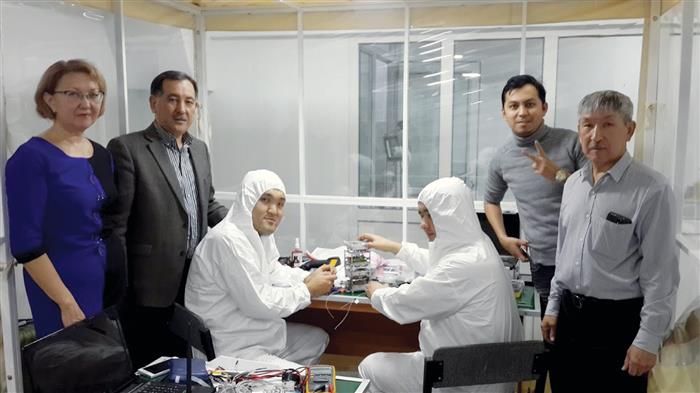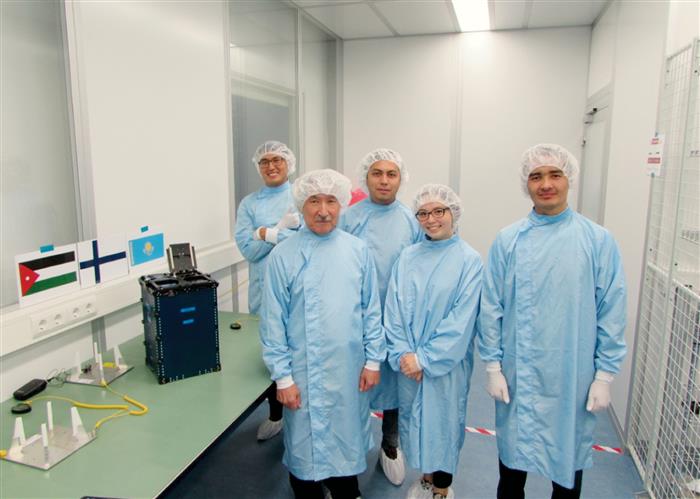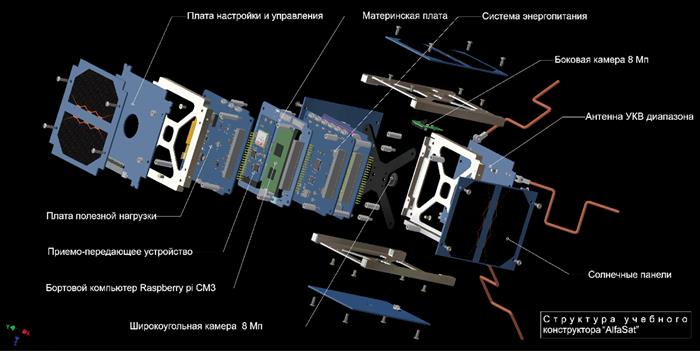- Main page
- News
Scientific school on the creation of nanosatellites
2/24/2022
Currently, many foreign innovative companies and leading universities are actively engaged in the development and creation of scientific, educational and commercial nanosatellites. Such satellites have gained popularity due to the fact that their creation does not require significant financial costs compared to traditional satellites. In addition, it became possible to train students through their participation in practical work, containing all the main stages.
One of the types of such projects is the design of nanosatellites. A nanosatellite (NS) is a spacecraft with a mass of no more than 10 kg. Now the most popular NS standard CubeSat. The term "CubeSat" refers to nanosatellites designed according to a standard created under the guidance of Professor Bob Twiggs (Department of Aeronautics and Astronautics, Stanford University). NS in the CubeSat format can be manufactured and launched into near-Earth orbit in the shortest possible time, and the most remarkable thing is that students and young scientists are widely involved in such projects. The low cost allows universities and commercial start-up companies to develop such NNs.

The NS of the CubeSat standard has dimensions of 10 × 10 × 10 cm, that is, it has the shape of a cube. The standard allows the combination of 2 or 3 standard cubes as part of one satellite (denoted 2U and 3U and have dimensions of 10 × 10 × 20 or 10 × 10 × 30 cm, respectively - these are the most common options). Today, nanosatellites have not only moved into an independent category of space vehicles, but are already solving a certain range of useful tasks in orbit, for example, monitoring geophysical fields, collecting and transmitting to Earth data on transportation by water and land, and obtaining images of the Earth from space.
The history of the launch of the first nanosatellites of KazNU of the Al-Farabi series dates back to 2009. This year, a new specialty "Space Technique and Technologies" was included in the classifier of higher and postgraduate education. Kazakh National University, named after Al-Farabi, was the first in the country to open the specialty "Space Technique and Technology", which is based on the Department of Mechanics of the Faculty of Mechanics and Mathematics. To develop a new direction, the head of the Department of Mechanics, Professor Zaure Rakisheva, invited one of the best specialists in the world in the development of small spacecraft, Professor Shinichi Nakasuka from the University of Tokyo, to cooperate.
In 2012, a memorandum was signed with the University of Tokyo on joint training of personnel in the field of creating small spacecraft. The idea of creating nanosatellites on the basis of Al-Farabi KazNU belonged to the then rector - Galymkair Mutanov, who proposed to develop them together with the University of Tokyo. In 2013, under the leadership of the rector, the project of the Ministry of Education and Science of the Republic of Kazakhstan was won, in which five doctoral and undergraduate students underwent scientific training at the University of Tokyo, working in the international project UNIFORM. Five undergraduates of KazNU received all the necessary knowledge and skills to create small spacecraft.

In the period 2015-2017. The project of program-targeted financing “Creation of a national scientific school for the development of space equipment and technologies” was carried out. Design, assembly and launch of the first Kazakh nanosatellite”. The main goal of the project was to train highly qualified specialists in the field of space technology, create and launch domestic nanosatellites and implement the corresponding ground infrastructure
As a result of the work performed, on February 15, 2017, the university launched the country's first nanosatellite. The spacecraft "Al-Farabi -1" is named after the outstanding scientist of the Turkic world, whose name the university bears. The country's first nanosatellite was launched in India from a cosmodrome in Andhra Pradesh. This launch was a record in terms of the number of spacecraft launched into space: 101 nanosatellites, 2 microsatellites and the main satellite of 712 kg were launched into low Earth orbit.
A little more than a year later, on December 4, 2018, the second nanosatellite of KazNU Al-Farabi-2 was launched into a sun-synchronous orbit. The satellite was launched by Elon Musk's famous company SpaceX.
Spacecraft, in addition to the main - educational mission, have a scientific, technological and real applied mission. The technological mission of the Al-Farabi-2 nanosatellite is to test in space the work of the on-board computer developed by the authors, as well as to test its own ground station and a number of software. The scientific mission is to study the effect of radiation on the memory cells of microcontrollers. In addition, Al-Farabi-2 has the function of greeting ground stations in more than 10 languages. Flying over different continents of the globe, the spacecraft automatically determines the broadcast radius for different countries and transmits a greeting signal in their language.

To date, KazNU has its own satellite platform AlfaSat, the stage of commercialization of the results of the work. After successful launches of university nanosatellites, scientists set about creating their own AlfaSat satellite platform for educational institutions. These kits are a model of a nanosatellite of the CubeSat-1U standard, which has all the main service subsystems of the spacecraft. It remains for schoolchildren and students to develop their own payload and integrate it with the AlfaSat space system for launching into the upper atmosphere.
Today, the university actively cooperates with scientific organizations from all over the world. In 2017, on the basis of the university, together with the RADI Institute (now AIR) of the Chinese Academy of Sciences, a center for remote sensing of the Earth was opened. The Center has a virtual ground station SatSee, which allows you to receive satellite images of remote sensing from 6 Chinese satellites with a spatial resolution of 2 to 30 m. This center is an important element of the created University Space Cluster and solves a wide range of tasks related to monitoring and assessing potential flood hazards , floods, fires and oil spills using satellite images, digital elevation models, and hydrometeorological information. The specialists of the center have created technologies for space monitoring of agricultural lands, natural biohazards, and solid waste landfills.

